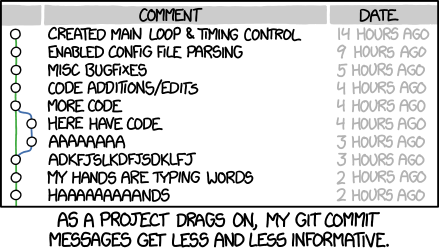Improve Your Commit Messages
In writing this I realized that this is not a sexy topic. This is probably due more to the fact that no one really
complains or cares about it. However, having worked on several projects and with many people, I have come to realize that
commit messages are like insurance policies (which are also not sexy). You don’t really want them but when you need
them they can really save your ass. If you have ever tried to sift through the commit history on your code base you’ll
quickly realize two things:
- Most people suck at writing informative commit messages
- You are one of those people that sucks
I have seen messages range from bug fixes all the way to Add new fancy js library. Sadly, a lot of them were
written by yours truly.

These types of commit messages have started to make me cringe as they don’t answer any of the questions one might have when looking at the commit history like:
- What feature/bug did you work on?
- Why is this even important?
- Does this fix something that was broken?
- Does this break anything else?
Sure some of those questions can be answered by going to look at a feature or bug ticket but I don’t want to have to
switch systems every time I need to find out more information about a commit. I’ll be honest, at first I didn’t really
have any thoughts on how we could improve these other than being more specific, in both the work we were performing
and our messages. When I say ‘work’ I mean the changes we are making to the code base.
So now that I have you feeling extremely crappy about your commit messages. Let’s go over how to get better. Here is the format we are going to be going for. Just a note, I am not randomly recommending this format this is actually based on the format suggested by git when submitting patches and further inspired by karma’s commit style. They are called semantic commit messages.
<type>(<scope>): <subject>
<BLANK LINE>
<body>
<BLANK LINE>
<footer>
Message Header
<type>(<scope>): <subject>
The message header is a concise single line description, under 75 characters, of the change. As we can see from the
template it contains a type, scope and a subject. We’ll cover these in more details below.
If you need to revert a previous commit use that commits header and prepend it with revert:. In the message body,
add a link to the SHA of the commit being reverted.
<type>
This describes the kind of change for the commit, from the list below:
- feat (new user feature)
- fix (bug fix on a user feature)
- docs (documentation updates)
- style (code style changes; no production code changes)
- refactor (refactoring production code)
- test (adding/refactoring tests; no production code changes)
- chore (updating gulp tasks; no production code changes)
<scope>
<scope> is an optional value and is based on the areas of your projects. These values are up to you to define.
<subject>
This is a short description of your change. Make sure to use the imperative (i.e. present ) tense (e.g. ‘Update’ vs
’Updated’ or ‘Change’ vs ‘Changes’).
Message Body
<body>
While you can think of the header as a ‘tweet’ think of the body as a mini-blog posting. Just like with the <subject>
we want to make sure we are using the present tense. Describe the what and why you made the changes and how
it differs from the original implementation. Bullet points are OK here and I actually prefer using them.
Message Footer
<footer>
The message footer is a spot to document any related issues that are closed like Closed #1234 or Closes #1234, #567
and to document any breaking changes.
Wrap Up
So putting all this together we will have commit messages that look like this:
feat(server): Update code to work
* Update server logic to not break
* Server logic was breaking before because it was wrong
Closes #12345